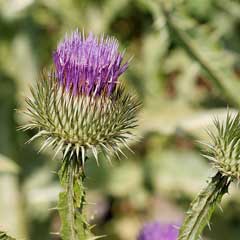 |
|
http://commons.wikimedia.org/wiki/File:Illustration_Onopordum_acanthium0.jpg |
 |
| http://commons.wikimedia.org/wiki/User:C_T_Johansson |
Translate this page:
Summary
Physical Characteristics

 Onopordum_acanthium is a BIENNIAL growing to 1.5 m (5ft) by 1 m (3ft 3in) at a slow rate.
Onopordum_acanthium is a BIENNIAL growing to 1.5 m (5ft) by 1 m (3ft 3in) at a slow rate.
See above for USDA hardiness. It is hardy to UK zone 6. It is in flower from July to September, and the seeds ripen from August to October. The species is hermaphrodite (has both male and female organs) and is pollinated by Bees. The plant is self-fertile.
It is noted for attracting wildlife.
Suitable for: light (sandy), medium (loamy) and heavy (clay) soils, prefers well-drained soil and can grow in nutritionally poor soil. Suitable pH: mildly acid, neutral and basic (mildly alkaline) soils. It can grow in semi-shade (light woodland) or no shade. It prefers dry or moist soil.
UK Hardiness Map
US Hardiness Map
Synonyms
Plant Habitats
Edible Uses
Flower buds - cooked. A globe artichoke substitute[2, 4, 9, 115, 183], though they are much smaller and very fiddly to use[K]. Stems - cooked. Used as a vegetable, they are a cardoon (Cynara cardunculus) substitute[2, 4]. The stems are cooked in water like asparagus or rhubarb[12]. They are best if the rind is removed[4, 115, 183]. Leaves and young plants - cooked[9, 105]. They are harvested before the flowers develop and the prickles must be removed prior to cooking[9]. The petals are an adulterant for saffron[46, 61, 105, 183], used as a yellow food colouring and flavouring. A good quality edible oil is obtained from the seed[2, 4, 183]. The seed contains about 25% oil[4].
References More on Edible Uses
Medicinal Uses
Plants For A Future can not take any responsibility for any adverse effects from the use of plants. Always seek advice from a professional before using a plant medicinally.
The flowering plant is cardiotonic[9]. It is used in some proprietary heart medicines[9]. The juice of the plant has been used with good effect in the treatment of cancers and ulcers[4]. A decoction of the root is astringent[4]. It is used to diminish discharges from mucous membranes[4].
References More on Medicinal Uses
The Bookshop: Edible Plant Books
Our Latest books on Perennial Plants For Food Forests and Permaculture Gardens in paperback or digital formats.

Edible Tropical Plants
Food Forest Plants for Hotter Conditions: 250+ Plants For Tropical Food Forests & Permaculture Gardens.
More

Edible Temperate Plants
Plants for Your Food Forest: 500 Plants for Temperate Food Forests & Permaculture Gardens.
More

More Books
PFAF have eight books available in paperback and digital formats. Browse the shop for more information.
Shop Now
Other Uses
The stem hairs are sometimes collected and used to stuff pillows[4]. An oil obtained from the seed is used as a fuel for lamps[4].
Special Uses
References More on Other Uses
Cultivation details
An easily grown plant, it succeeds in almost any ordinary garden soil[1, 111]. Requires a well-drained soil, preferably in full sun though it tolerates light shade[200]. Prefers a slightly alkaline soil[200]. Grows very well in poor soils, succeeding in hot dry situations and tolerating drought when it is established[190]. A slow-growing plant[188]. Hardy to about -15°c[200]. A very ornamental plant[1], the flowers are very attractive to bees[200]. Plants are prone to slug and snail damage[188]. Often self-sows, sometimes to the point of nuisance, though the seedlings can easily be hoed out and can also be transplanted if they are moved whilst still small[200].
References Carbon Farming Information and Carbon Sequestration Information
Temperature Converter
Type a value in the Celsius field to convert the value to Fahrenheit:
Fahrenheit:
The PFAF Bookshop
Plants For A Future have a number of books available in paperback and digital form. Book titles include Edible Plants, Edible Perennials, Edible Trees,Edible Shrubs, Woodland Gardening, and Temperate Food Forest Plants. Our new book is Food Forest Plants For Hotter Conditions (Tropical and Sub-Tropical).
Shop Now
Plant Propagation
Seed - sow spring in situ[200]. The seed can also be sown in situ in autumn[200]. If the seed is in short supply then it can be sown in a pot in the greenhouse in the spring. Prick out the seedlings into individual pots as soon as they are large enough to handle and plant them out into their permanent positions in early summer.
Other Names
If available other names are mentioned here
Native Range
TEMPERATE ASIA: Afghanistan, Iran, Iraq (north), Turkey, Russian Federation-Ciscaucasia (Ciscaucasia), Armenia, Azerbaijan, Georgia, Russian Federation (Dagestan), Kazakhstan, Kyrgyzstan, Tajikistan, Turkmenistan, Uzbekistan, China (Xinjiang Uygur Zizhiqu (north)) TROPICAL ASIA: India (Jammu and Kashmir), Pakistan (north) EUROPE: Austria, Switzerland, Czech Republic, Germany, Hungary, Netherlands, Slovakia, Belarus, Moldova, Ukraine (incl. Krym), Albania, Bulgaria, Bosnia and Herzegovina, Greece, Croatia, Italy, North Macedonia, Montenegro, Romania, Serbia, Slovenia, Spain, France, Portugal AFRICA: Algeria
Weed Potential
Right plant wrong place. We are currently updating this section.
Please note that a plant may be invasive in one area but may not in your area so it’s worth checking.
Conservation Status
IUCN Red List of Threatened Plants Status :

Growth: S = slow M = medium F = fast. Soil: L = light (sandy) M = medium H = heavy (clay). pH: A = acid N = neutral B = basic (alkaline). Shade: F = full shade S = semi-shade N = no shade. Moisture: D = dry M = Moist We = wet Wa = water.
Expert comment
Author
L.
Botanical References
17200
Links / References
For a list of references used on this page please go here
Readers comment
| Add a comment |
|
If you have important information about this plant that may help other users please add a comment or link below. Only comments or links that are felt to be directly relevant to a plant will be included. If you think a comment/link or information contained on this page is inaccurate or misleading we would welcome your feedback at [email protected]. If you have questions about a plant please use the Forum on this website as we do not have the resources to answer questions ourselves.
* Please note: the comments by website users are not necessarily those held by PFAF and may give misleading or inaccurate information.
To leave a comment please Register or login here All comments need to be approved so will not appear immediately.
|
Subject : Onopordum_acanthium
|
|
|
|